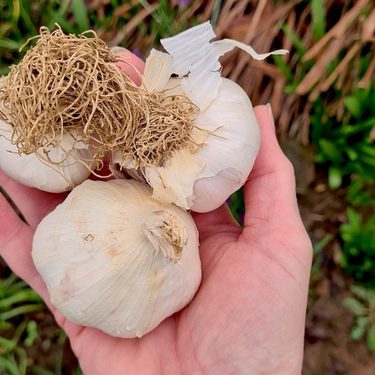
Garlic
- Tags
- Vegetables and herbs Growing Guides
| Growing calendar | |
|---|---|
| Plant out | November-February |
| Harvest | May-August |
Autumn is the perfect time to get this crop in the ground. It tends to produce higher yields as plants need one or two months at 0-10C to spring into action.
It's best to buy garlic bulbs from trusted, organic suppliers, as garlic from supermarkets can be sprayed with chemicals and inhibitors that stop growth and prevent disease.
How to grow garlic
Select from soft neck varieties, which have abundant cloves. These are the kind that can be plaited and stored for long periods. Or choose hard neck types, for their lovely flavour. These tend to run to seed more easily. You can also buy ‘elephant garlic’, which produce giant cloves and has a milder flavour.
You don’t want the ground or compost to be too wet so choose a nice, sunny spot. Add some well-rotted organic matter and keep it weed free.
Split your bulb carefully and plant individual bulb segments (‘cloves’) 10cm apart in rows 20cm apart. Plant upright 2.5cm deep in heavy clay soil; up to 10cm deep in sandy soil.
Harvesting and using garlic
Carefully dig out garlic when the first four to six leaves turn yellow. Keep in a dry place for a few weeks (if the weather is fine, they can stay outside resting above the ground.) Bulbs are ready to store when skins are dry and papery. Plait into ropes or hang in net sacks which allow the air to circulate freely.
Troubleshooting tips for garlic
It’s best to wait until conditions are drier as garlic rots in wet soil. If conditions are poor, try starting off indoors in a cool greenhouse. Plant the cloves in modules of peat-free compost and plant them out when the weather improves. Also avoid watering after the bulb has formed.
| Growing notes | |
|---|---|
| Difficulty | Easy |
| Germination time | 14 days |
| Average time to harvest | 20 weeks |
| Equipment needed | Airy shed |
| Average plant size | 30cm tall, 5-10cm wide |
| Family group to grow with | Alliaceae: leek, onion |
| Seed saving notes | 5 - specialist |